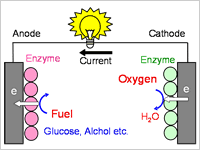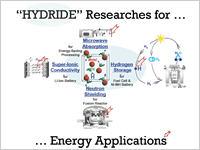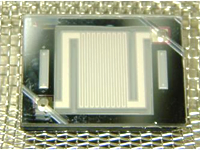Five research groups maintain close collaboration to carry out the research on Nano Energy Systems. The followings are some of our representative research areas:
1)Micro Energy Harvesting from Ambient Vibrations, Temperature Gradient, and Micro-explosion (Kuwano Lab)

A vibration-driven micro power generator harvests energy from ambient vibrations and converts it to electricity. There are mainly three physical means for electromechanical conversion: the use of piezoelectric effect, the use of an electret, and the electromagnetic conversion. Our group studies all these methods in order to systematically find out both their advantages and disadvantages. Furthermore, we are developing a new, "intelligent" energy harvesting scheme that would efficiently absorb energy from unpredictable wideband vibrations, that is in fact common in the real environment.
In the micro-thermoelectric power generation project, we have been developing thermal management devices in the micro/nano region. Optimal materials and structures of the thermal interface to enable smooth heat transfer are necessary for the future thermoelectric devices constructed with thermoelectric materials in the form of thin film, wire and/or dots. Optical confinement structures for thin film solar cells, as well as heat radiation techniques to reduce wire losses have also been developed.
The Micro Detonation Engine project is aiming at developing a high efficiency small energy conversion system using detonative combustion. Detonation in a condensed medium, that is solid and liquid explosives, typically has a smaller detonation limit than gaseous detonation, and thus has an advantage in downsizing the energy conversion system.
2)A bio fuelcell (Nishizawa Lab)

Bio-fuel cells employs enzymes as electrode catalysts. The advantage of such a fuel cell is that it could be made entirely of harmless organic materials; for instance, even soft drinks could be used as a fuel. Therefore, bio-fuel cells can be made truly environmentally- friendly. They could even be eaten.
One application area of such a small, safe battery is medicine. In particular, it has been estimated that the output of an implanted bio-fuel cell, which uses glucose in blood stream as a fuel, would be sufficient to power devices such as bio-sensors. While there are still many problems to be solved, such as the problem of durability, once realized they will be extremely safe, compatible with biological matters, and environmentally friendly.
3)New Materials for Nano Energy Applications (Orimo Lab, the Institute for Materials Research)

High-density hydrogen-storage materials will be essential in the future society based on the hydrogen economy. Our activities include not only synthesizing novel hydrogen compounds that has light metallic elements and/or conspicuous nano-structure, but also employment of a wide variety of analytical method into atomic and electronic structures, as well as processes based on microwaves. Furthermore, we investigate related research areas pertaining to the energy-related aspects of hydrogen compounds such as nickel-hydrogen battery materials, neutron shielding materials, and lithium-based super-ionic conductors. Our research spans from basic research to applied research involving industry partners, and moreover, we participate in the hydrogen- storage materials research program of the International Energy Agency (IEA), which allows us to develop an international network.
4)Thermionic Power Generation based on Nanomaterials (Ono Lab)
We are developing power generation devices that take advantage of thermionic electron emission from a nano-material. The device converts heat into electricity: By heating the electron emitter made of nano-material, the emitted electrons flow into the collector electrode. A higher power generation efficiency will be achieved by a high degree of electric field concentration at the apex of the nanomaterial, as well as by reducing the gap between the emitter and the collector. The carbon nanotube, for instance, will be used as a nano-material.
5)Micro Fuel Cells (Tanaka Lab)

Micro fuel cells are expected as a next-generation power source for portable devices. While conventional rechargeable batteries are facing the theoretical limit in terms of energy density, the micro fuel cell has a potential of achieving a several times higher level of energy density than the current rechargeable battery. The micro fuel cells also have advantages not only in the ability of rapid energy charging with a fuel cartridge, but also in reducing environmentally harmful wastes.
The largest challenge for the practical applications is about increasing power density. The current level of power density is relatively small, which prevents the total system from being small enough for the practical use, and thus the reduced fuel volume compromises the high energy potential of the fuel cell.
The goal of this project is to achieve high power density. To this end we develop micro fuel reformers, micro SOFCs (solid oxide fuel cell), and thermal isolation techniques for those packages. Related technologies, such as micromachining and deposition of functional materials are also our key research topics.
In the later part of the project, we are going to investigate how to optimally combine the above technologies into useful integrated nano energy systems.

